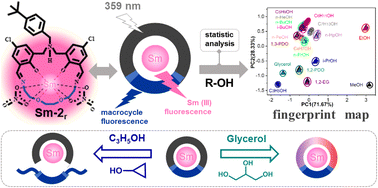Highly selective and discriminative detection of small alcohols based on a dual-emission macrocyclic samarium complex†
Abstract
Lower alcohols (C1–C7) have a close relationship with our lives and some of them are harmful to our body's health. For example, liquor mixed with a tiny amount of methanol is harmful to our health. Much of this study is about identifying one or two low-level alcohols. How to detect low-level alcohol and high-throughput and distinguish between analogues of alcohol remains a tremendous challenge. In this study, a new large ring Schiff base Sm(III) complex (Sm-2r) is synthesized with a double emission matrix using the template method. Its dynamic imine bond (C![[double bond, length as m-dash]](https://www.rsc.org/images/entities/char_e001.gif) N) and organic ligands (H2L2r) with molecular rotor properties can respond to changes in viscosity and polarity in external environments. The PCA method is used to turn the data matrix into a fingerprint spectrum to distinguish different alcohols (C1–C7). Sm-2r enables the quantization of cyclopropyl and glycerol. Linear ranges of cyclopropanol and glycerol are 0–9.0% and 0–3.0% (v/v), respectively. In addition, Sm-2r has an excellent ability to distinguish the mixtures of n-PrOH and i-PrOH, C5H9OH and C6H11OH, n-PeOH and n-HeOH, 1,3-PDO and 1,2-PDO, MeOH and EtOH, 1,2-EG and 1,2-PDO at different volume ratios. We have provided a way to distinguish alcohol species based on their molecular polarity and viscosity.
N) and organic ligands (H2L2r) with molecular rotor properties can respond to changes in viscosity and polarity in external environments. The PCA method is used to turn the data matrix into a fingerprint spectrum to distinguish different alcohols (C1–C7). Sm-2r enables the quantization of cyclopropyl and glycerol. Linear ranges of cyclopropanol and glycerol are 0–9.0% and 0–3.0% (v/v), respectively. In addition, Sm-2r has an excellent ability to distinguish the mixtures of n-PrOH and i-PrOH, C5H9OH and C6H11OH, n-PeOH and n-HeOH, 1,3-PDO and 1,2-PDO, MeOH and EtOH, 1,2-EG and 1,2-PDO at different volume ratios. We have provided a way to distinguish alcohol species based on their molecular polarity and viscosity.



 Please wait while we load your content...
Please wait while we load your content...